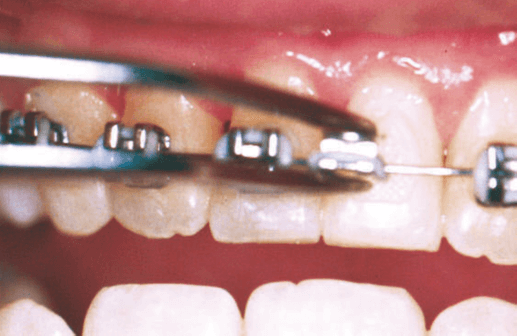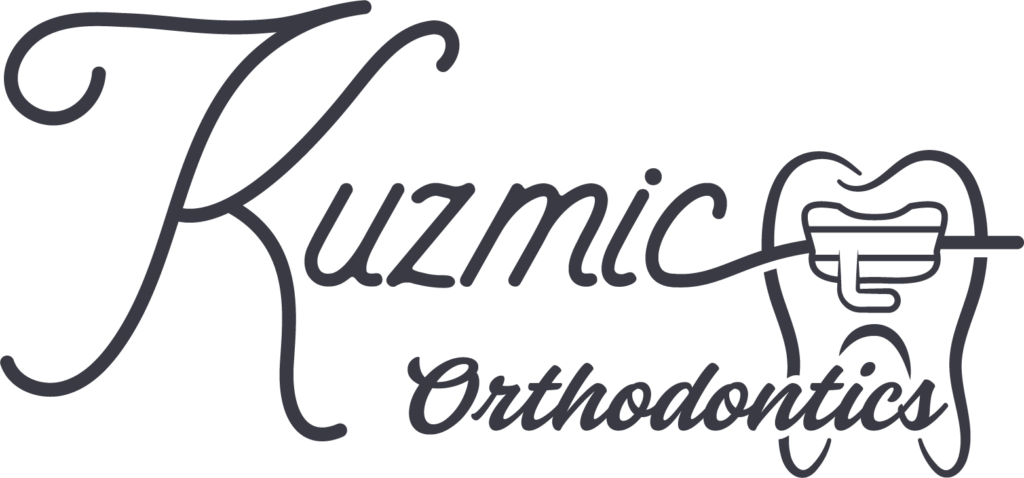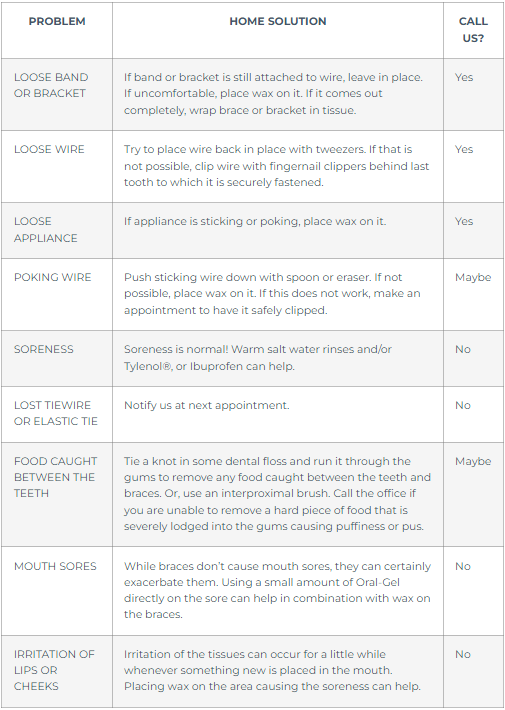TRANSPARENCY AND COMFORT ARE OUR HALLMARKS
Post-Op Instructions For Orthodontic Appliances

Click on the appliance you have on!
Wear the aligners full time a minimum of 22 hours/day. The aligners should not be out more than 2 hours/day. Take aligners out only to brush, floss, eat and drink (only drink water with them in).
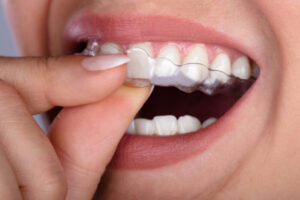 When you begin wearing a new set, they may not fit quite like you think they should. This is normal. Use aligner chewies EVERY DAY throughout your ENTIRE treatment to help the fitting of the aligners. (Chew for 5-10 minutes the first 1-2 days. Then for about 15-30 seconds every time the aligners are placed aligners back into your mouth.) It is important that the aligners fit well before you switch to a new set. If the aligners do not fit well, then do not switch to a new aligner. There should be no gap between the tooth and the aligner. Call our office to schedule an appointment with Dr. Kuzmic if the aligners are not fitting well.
When you begin wearing a new set, they may not fit quite like you think they should. This is normal. Use aligner chewies EVERY DAY throughout your ENTIRE treatment to help the fitting of the aligners. (Chew for 5-10 minutes the first 1-2 days. Then for about 15-30 seconds every time the aligners are placed aligners back into your mouth.) It is important that the aligners fit well before you switch to a new set. If the aligners do not fit well, then do not switch to a new aligner. There should be no gap between the tooth and the aligner. Call our office to schedule an appointment with Dr. Kuzmic if the aligners are not fitting well.
Switch to the next aligner at night before bedtime. Before putting a new set of aligners make sure to rinse them. Changing aligners at night allows easier removal in the morning and minimizes any discomfort that you may have.
Check attachments daily. If an attachment comes off or partially breaks off a tooth, do not switch to a new aligner. Call the office to replace attachment first before switching.
If you lose the aligner you are wearing, then start wearing the next aligner even if you are not due to switch to the next aligner. Wear this aligner all the way through when you would have worn it normally, and use chewies to help it fit. If you don’t have the next aligner then go back to the previous aligner and call our office.
Always keep at least the previous 2 aligners and bring them with you to your appointment. If you finish the last aligner that was given to you before you have your next appt, continue to wear the last aligner until your next appointment.
Occasionally you may have a sharp edge on an aligner. You may use an emery board or sandpaper to carefully smooth it.
Cleaning aligners: brush aligners daily with mild soap. Soak weekly or more often in denture cleaner, white vinegar or Steraligner. Do not use mouthwash since it can discolor aligners. Do not use toothpaste because it can wear away the plastic.
If you have any kind of pets, KEEP THEM IN THE CASE AND OUT OF THE PET’S REACH. They love the smell of your saliva and will eat them at any opportunity!
If the aligners are not in your mouth they should be in the CASE to avoid loss or breakage. Always keep a CHEWY in your case. Remember, if it’s not in your face it’s in your case!
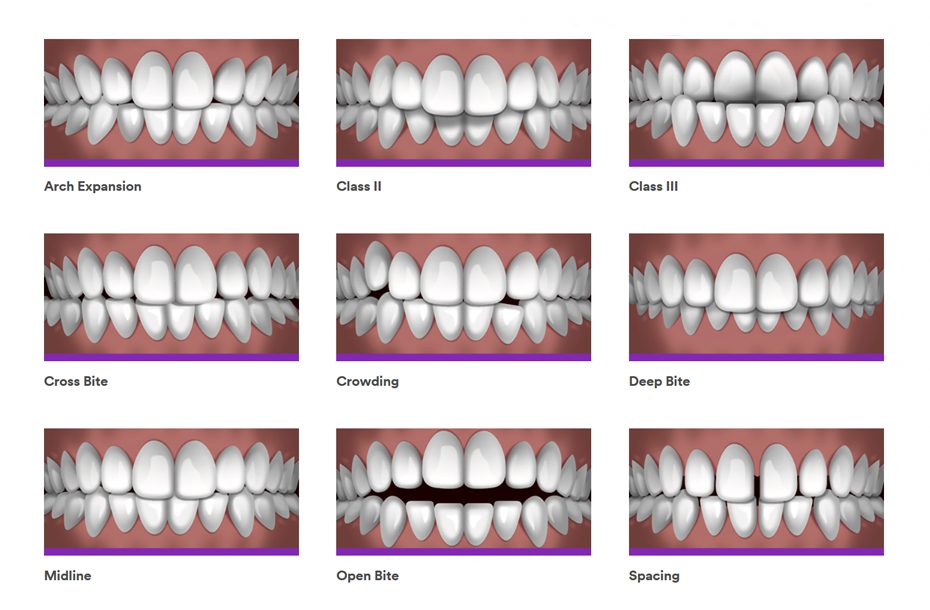
THOSE BRACES LOOK GOOD ON YOU!
I know that right now it may feel weird to talk and bite, that’s okay! A week from today you will be much more used to your braces. If not already, your teeth could start to feel a bit sore. This is normal for 1-2 weeks after a braces appointment, that just means they are working! Just like after exercising, soreness is normal. I’m very proud that you have started your orthodontic journey with us, and don’t hesitate to call us if you need to! You are now part of the Kuzmic Orthodontic Family.
- Kyle Kuzmic, DDS, MS
Get to know your braces
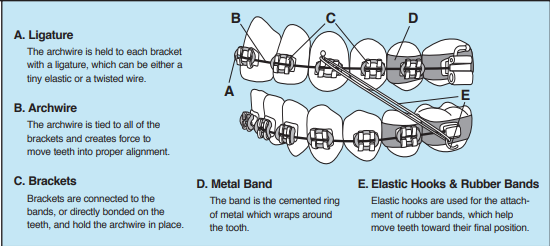
PROBLEMS AND SOLUTIONS
You may be able to solve many braces problems temporarily by yourself until you schedule a repair appointment. These problems need not delay your treatment.
| PROBLEM | HOME SOLUTION | CALL US? |
|---|---|---|
| LOOSE BAND OR BRACKET | If band or bracket is still attached to wire, leave in place. If uncomfortable, place wax on it. If it comes out completely, wrap brace or bracket in tissue. | Yes |
| LOOSE WIRE | Try to place wire back in place with tweezers. If that is not possible, clip wire with fingernail clippers behind last tooth to which it is securely fastened. | Yes |
| LOOSE APPLIANCE | If appliance is sticking or poking, place wax on it. | Yes |
| POKING WIRE | Push sticking wire down with spoon or eraser. If not possible, place wax on it. If this does not work, make an appointment to have it safely clipped. | Maybe |
| SORENESS | Soreness is normal! Warm salt water rinses and/or Tylenol®, or Ibuprofen can help. | No |
| LOST TIEWIRE OR ELASTIC TIE | Notify us at next appointment. | No |
| FOOD CAUGHT BETWEEN THE TEETH | Tie a knot in some dental floss and run it through the gums to remove any food caught between the teeth and braces. Or, use an interproximal brush. Call the office if you are unable to remove a hard piece of food that is severely lodged into the gums causing puffiness or pus. | Maybe |
| MOUTH SORES | While braces don’t cause mouth sores, they can certainly exacerbate them. Using a small amount of Oral-Gel directly on the sore can help in combination with wax on the braces. | No |
| IRRITATION OF LIPS OR CHEEKS | Irritation of the tissues can occur for a little while whenever something new is placed in the mouth. Placing wax on the area causing the soreness can help. | No |
Piece of appliance is swallowed
This is rare, but when it does happen, it can be fairly alarming to the patient. Encourage your patient to remain calm. If the patient is coughing excessively or having difficulty breathing, the piece could have been aspirated. If you are able to see the piece, you may carefully attempt to remove it. But do not make the attempt if you could cause harm. If appropriate under the circumstances, examine the patient’s braces for problems that may result from the missing piece, such as looseness or irritation, and treat as specified above. If you are unable to see the piece and believe it may be have been aspirated, notify the parent/guardian and the orthodontist immediately.
If you feel you are unable to handle a problem on your own or with help from family, please call us as soon as possible.
ORTHODONTIC DIET CHART
Foods that cannot be cleaned off the braces may lead to discoloration and decay of your teeth. Even though our braces and wires are metal, they are fragile and are usually damaged by eating the wrong foods, thus taking us longer to finish your treatment.
In general, please avoid foods that are HARD, STICKY, and CHEWY.
ABSOLUTELY NO – WILL BREAK BRACKETS!
GUM
- Sugarless Or Otherwise
STICKY FOODS
- Caramels
- Caramel Apples
- Gummy Bears
- Taffy
- Licorice
- Starbursts
- Toffee
- Tootsie Rolls
HARD FOODS
- Carrots/Apples (unless cooked or cut into small pieces)
- Bagels/Hard Bread
- Corn on the Cobb
- Hard Chips
- Pizza Crusts
- Popcorn
- Jerky
- Hard Candy
- Hard Pretzels
- Hard Nuts
- Ice
- Raw Vegetables
- Granola Bars
MINIMIZE SUGAR INTAKE – CAUSES CAVITIES!
EAT MUCH LESS
- Cake
- Candy
- Cookies
- Ice Cream
- Pie
- Syrup
DRINK MUCH LESS
- Soda Pop
- Energy Drinks
- Sports Drinks (Gatorade/Powerade)
- Sugary Drinks (Tea, Coffee with Sugar, Fruit Drinks)
AVOID CHEWING ON PENS, PENCILS, AND FINGERNAILS
In order to become an orthodontist, Dr. Kuzmic tested the bond strength of braces and the hardness of different foods in a lab to determine scientifically which foods are the worst! His data can be seen in the Aggie Bite Chart in the office!
Food caught Between Teeth
This is not an emergency, but can be a little uncomfortable or embarrassing for the braces wearing patient. It is easily fixed with a piece of dental floss. Try tying a small knot in the middle of the floss to help remove the food, or use an interproximal brush or toothpick to dislodge food caught between teeth and braces.
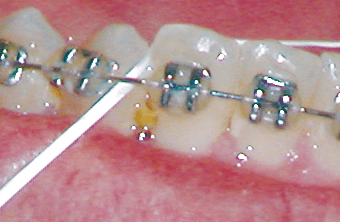
Ligatures come Off
Tiny rubber bands or small, fine wires, known as ligatures, hold the wire to the bracket. If a rubber ligature should come off, you may be able to put it back in place using sterile tweezers. If a wire ligature comes loose, simply remove it with sterile tweezers. If the wire ligature is sticking out into the lip but is not loose, it may be bent back down with a Q-tip or pencil eraser to eliminate the irritation. Of course, when one ligature pops off or breaks, others may follow. Be sure to examine all ligatures. Missing or broken ligatures should be brought to the attention of the patient’s parent/guardian, who should then inform the orthodontist. If a rubber or wire ligature is lost, notify the parent/guardian so that the orthodontist may advise whether the patient should be seen.
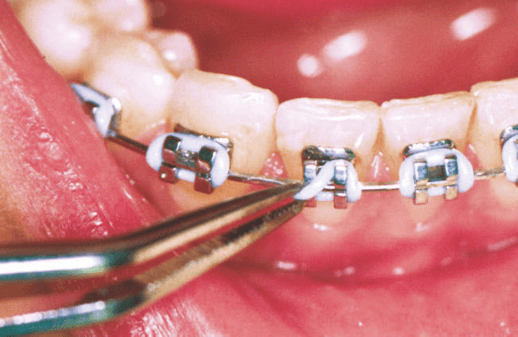
Discomfort
It’s normal for a patient to have discomfort for a day or two after braces or retainers are adjusted. But it can make eating uncomfortable. Reassure the patient that the discomfort is both normal and temporary. Encourage soft foods. Have the patient rinse the mouth with warm salt water.
Mouth Sores
Some patients are susceptible to episodes of mouth sores. While braces do not cause them, they may be precipitated or exacerbated by an irritation from braces. One or several areas of ulceration of the cheeks, lips or tongue may appear. This is not an emergency, but may be very uncomfortable for the patient. Prompt relief may be achieved by applying a small amount of topical anesthetic (such as Orabase or Ora-Gel) directly to the ulcerated surface using a cotton swab. Instruct the patient to reapply as needed.
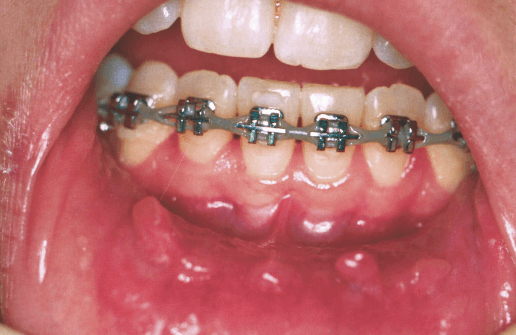
Irritation of Lips or cheeks
Sometimes new braces can be irritating to the mouth, especially when the patient is eating. A small amount of non-medicinal relief wax makes an excellent buffer between metal and mouth. Simply pinch off a small piece and roll it into a ball the size of a small pea. Flatten the ball and place it completely over the area of the braces causing irritation. The patient may then eat more comfortably. Let the patient know that if the wax is accidentally ingested, it’s not a problem. The wax is harmless.
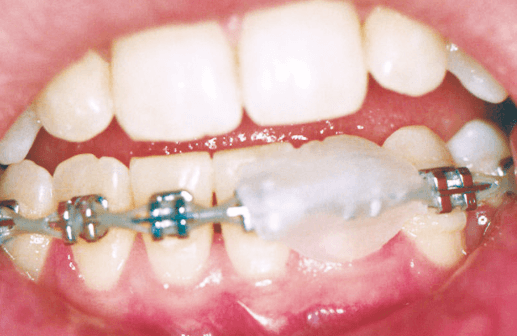
Protruding Wire
Occasionally, the end of a wire will work itself out of place and irritate the patient’s mouth. Use a Q-tip or pencil eraser to push the wire so that it is flat against the tooth. If the wire cannot be moved into a comfortable position, cover it with relief wax. (See Irritation of Lips or Cheeks above for instructions on applying relief wax.) The patient’s parent/guardian will need to make the orthodontist aware of the problem. In a situation where the wire is extremely bothersome and the patient will not be able to see the orthodontist anytime soon, you may, as a last resort, clip the wire. Reduce the possibility of the patient swallowing the snipped piece of wire by using folded tissue or gauze around the area. Use a pair of sharp clippers and snip off the protruding wire. Relief wax may still be necessary to provide comfort to the irritated area.
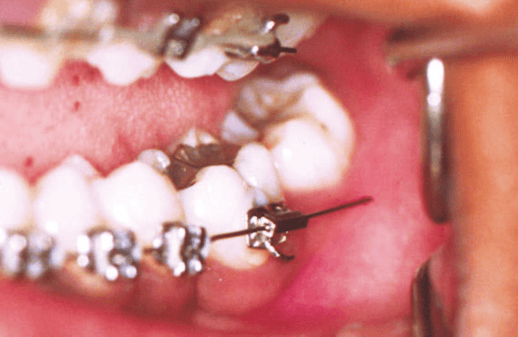
Loose Brackets, Wires or Bands
If the braces have come loose in any way, the parent/guardian needs to be notified, and they should call the orthodontist to determine appropriate next steps. Brackets are the parts of braces attached to teeth with a special adhesive. They are generally positioned in the center of each tooth. The bracket can be knocked off if the patient has eaten one of those hard or crunchy foods orthodontic patients are instructed to avoid, or if the mouth is struck while at play. (Encourage all patients, especially those with braces, to wear a protective mouth guard while playing sports.) If the bracket is off center, the adhesive may have failed.
Call the parent/guardian, and recommend that they immediately notify the orthodontist, who will determine the course of action. If the loose bracket has rotated on the wire and is sticking out and the patient cannot immediately be taken to the orthodontist, you can do a temporary fix to alleviate discomfort and prevent further damage. But take care to prevent swallowing or other injury. To put the bracket back in place, use sterile tweezers to slide the bracket along the wire until it is between two teeth. Rotate the bracket back to the proper position, then slide it back to the center of the tooth.
